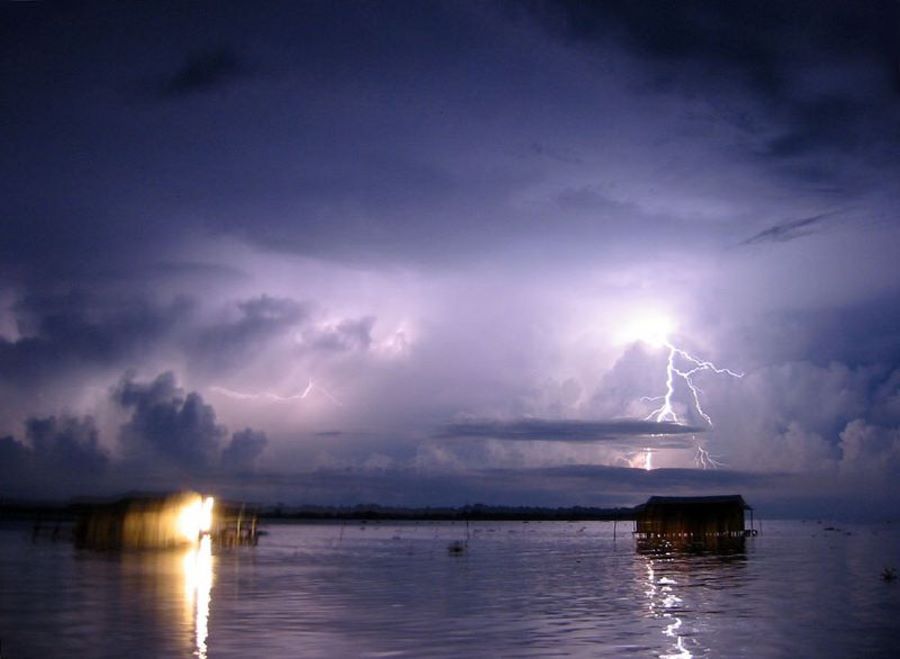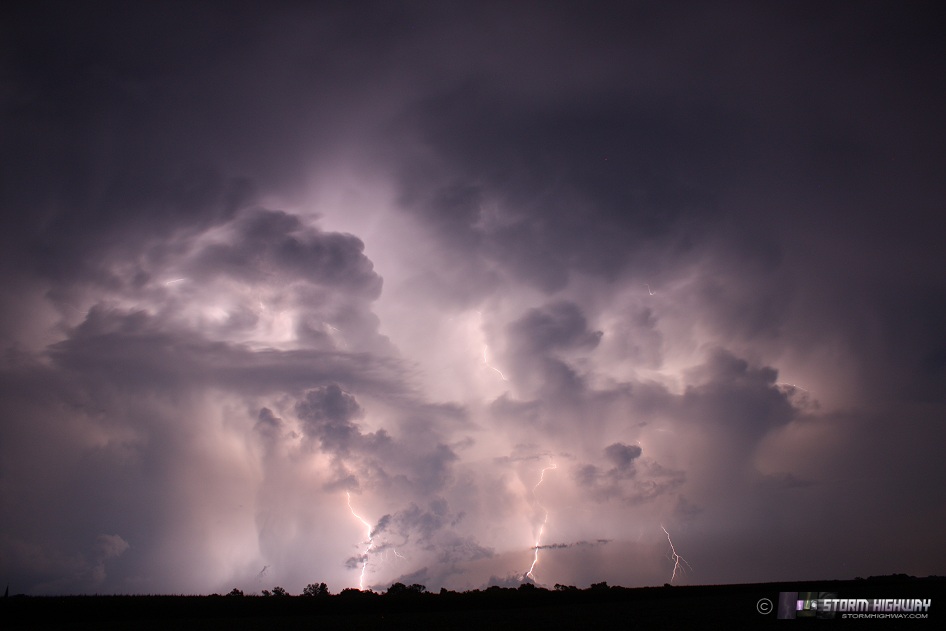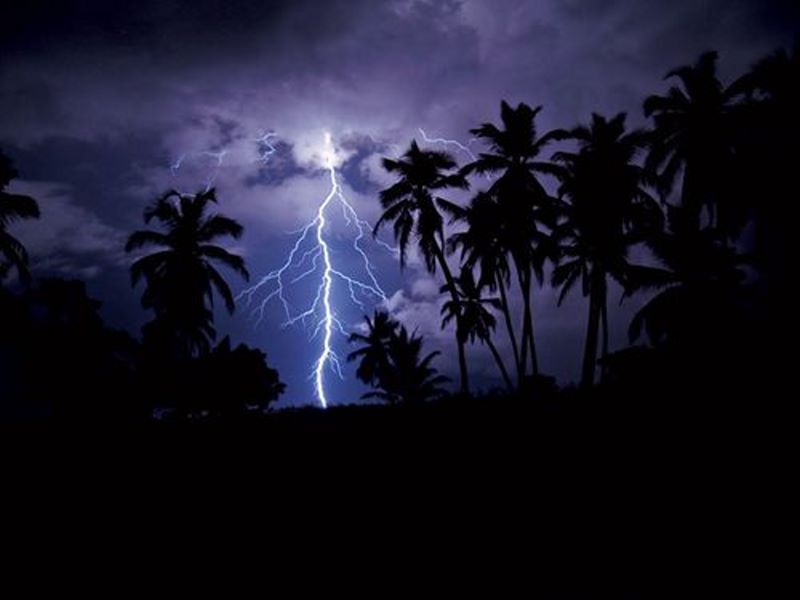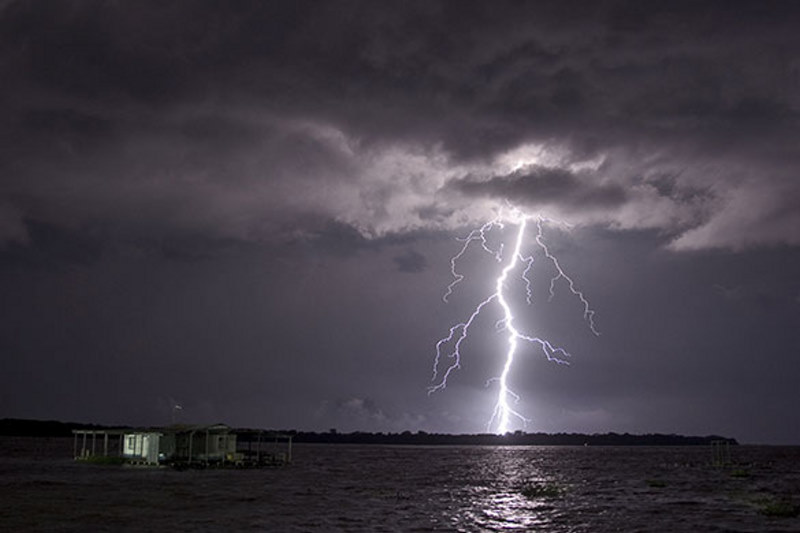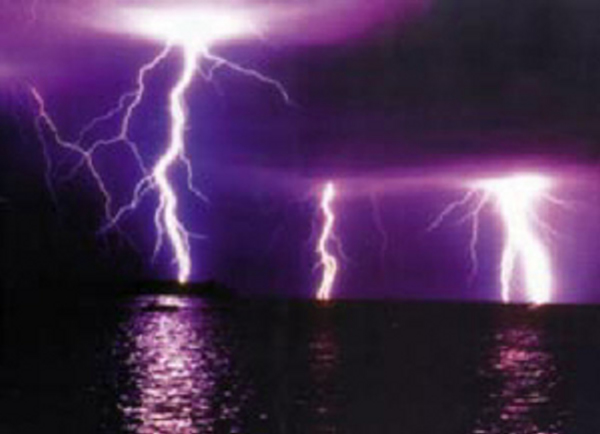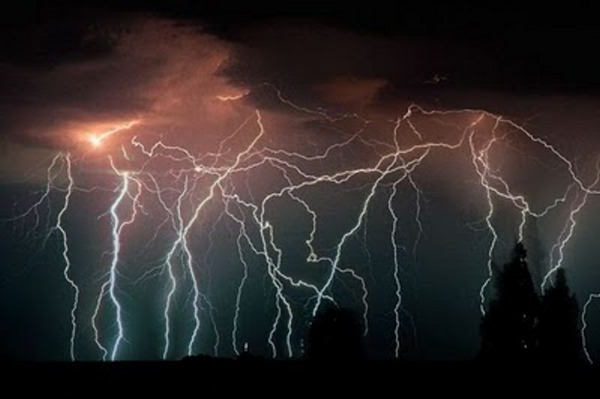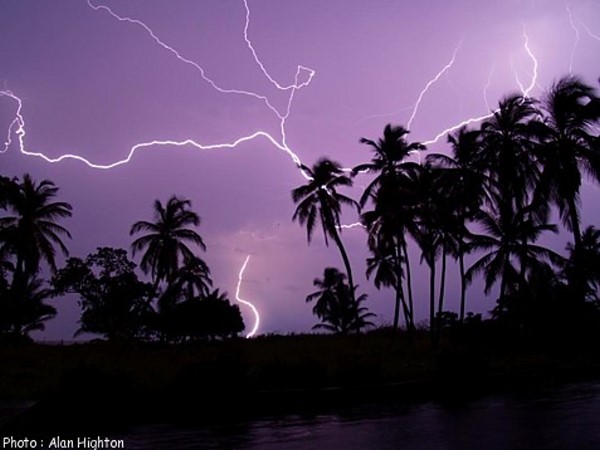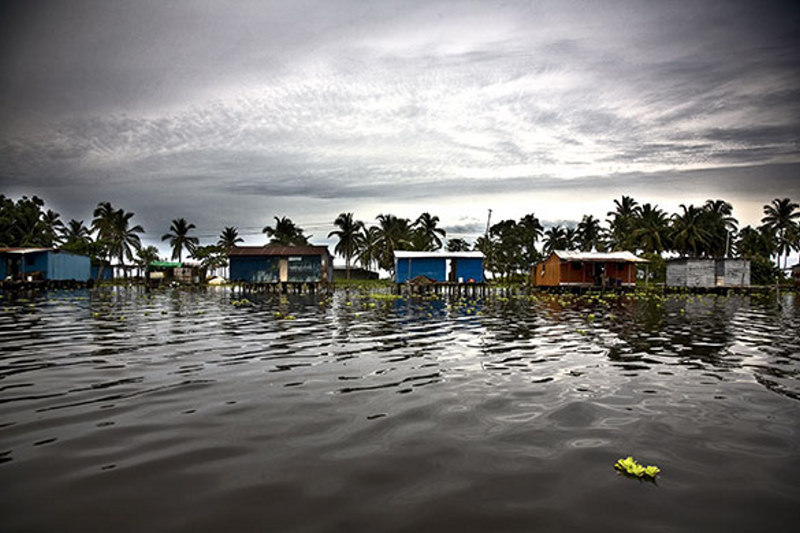|
Lightning |
|||||
|
..
Venezuela Permanent Storm The mysterious “Relampago del Catatumbo” (Catatumbo lightning) is a unique natural phenomenon in the world. Located on the mouth of the Catatumbo river at Lake Maracaibo (Venezuela), the phenomenon is a cloud-to-cloud lightning that forms a voltage arc more than five kilometer high during 140 to 160 nights a year, 10 hours a night, and as many as 280 times an hour. This almost permanent storm occurs over the marshlands where the Catatumbo River feeds into Lake Maracaibo and it is considered the greatest single generator of ozone in the planet, judging from the intensity of the cloud-to-cloud discharge and great frequency. The area sees an estimated 1,176,000 electrical discharges per year, with an intensity of up to 400,000 amperes, and visible up to 400 km away. This is the reason why the storm is also known as the Maracaibo Beacon as light has been used for navigation by ships for ages.The collision with the winds coming from the Andes Mountains causes the storms and associated lightning, a result of electrical discharges through ionised gases, specifically the methane created by the decomposition of organic matter in the marshes. Being lighter than air, the gas rises up to the clouds, feeding the storms. Some local environmentalists hope to put the area under the protection of UNESCO, as it is an exceptional phenomenon, the greatest source of its type for regenerating the planet’s ozone layer. |
|||||
|
..
Catatumbo Lightning The Catatumbo Lightning (Spanish Relámpago del Catatumbo)[1] is an atmospheric phenomenon in Venezuela. It occurs strictly in an area located over the mouth of the Catatumbo River where it empties into Lake Maracaibo. The frequent, powerful flashes of lightning over this relatively small area are considered to be the world's largest single generator of troposphericozone[2] but not replenishing the ozone layer, as the latter is located in the stratosphere[3]. It originates from a mass of storm clouds that create a voltaic arc at more than 5 km of height, during 140 to 160 nights a year, 10 hours per day and up to 280 times per hour. It occurs over and around Lake Maracaibo, typically over a bog area that forms where the Catatumbo River flows into the Venezuelan lake.[4] After appearing continually for centuries, the lightning was not seen for several months between January and April 2010 [5], apparently due to a drought, raising fears that it may have been extinguished permanently.[6] Location and formation mechanism The Catatumbo lightning usually develops between the coordinates 8 ° 30 'and 9 º 45' north latitude and 71 º and 73 º west latitude. The storms (and associated lightning) are likely the result of the winds blowing across the Maracaibo Lake and surrounding swampy plains. These air masses inevitably meet the high mountain ridges of the Andes, the Perijá Mountains (3,750m), and Mérida's Cordillera, enclosing the plain from three sides. The heat and moisture collected across the plains creates electrical charges and, as the air masses are destabilized at the mountain ridges, resulting in almost continual thunderstorm activity[5]. The phenomenon is characterized by almost continuous lightning, mostly within the clouds, which is produced in a large vertical development of clouds that form large electric arcs between 2 and 10 km in height (or more). The lightning tends to start approximately one hour after dusk. Among the major modern studies there is the one done by Melchor Centeno, who attributes the origin of the thunderstorms to closed wind circulation in the region. Between 1966 and 1970 the scientist Andrew Zavrostky with assistance from the University of Los Andes made three expeditions which concluded that the area would have several epicentres in the marshes of the Swamp National Park Juan Manuel de Aguas, Claras Aguas Negras and west Lake Maracaibo, and in 1991 he suggested that the phenomenon occurred due to cold and warm air currents meeting around the area. The study also speculated that an isolated cause for the lightning might be the presence of uranium in the bedrock.[7] Between 1997 and 2000 Nelson Falcón conducted several expeditions and produced the first microphysics model of the Catatumbo Lightning identifying the methane produced by the swamps and the oil deposits in the area as a major cause of the phenomenon[8]. It has been noted to have little effects on local flora such as ferns, despite concerns.[9] Historical references Historically the first written mention of the Catatumbo lightning was in the epic poem "La Dragontea" by Lope de Vega (1597) where the defeat of the English pirate or privateer Sir Francis Drake is narrated. The Prussian naturalist and explorer Alexander von Humboldt once described it as "electrical explosions that are like phosphorescent gleam". Italian geographer Agustin Codazzi described it as a "lightning that seems to arise from the continued Zulia river and its surroundings". The phenomenon became so celebrated that it was depicted in the flag and coat of arms of the state of Zulia, which contains Lake Maracaibo, and mentioned in the state's anthem. This phenomenon, for century popularly known as the Lighthouse of Maracaibo since its lights are visible for miles out at sea[10] and the boats that sail the area navigate at night without any problems, e.g. from the lake (where no clouds usually occur at night). References:
Storm Chaser George Kourounis Investigates the Catatumbo Lightning Phenomenon |
|||||
|
.. Uploaded
on Dec 1, 2009
They say that lightning never strikes twice, but nothing could be further from the truth for residents of a small village in western Venezuela. A unique meteorological phenomenon sets the sky alight for nearly half the year. The scientific community, though not yet unified as to the exact reason behind this phenomenon, wants it recognised as a UNESCO Natural Heritage Site. Congo Mirador - home to the Relampago de Catatumbo, or Catatumbo Lightning. As the sun sets fishing boats make their way home with the day's catch just before night falls upon this quiet river village... visit ebrunews.com for more info & news... |
|||||
|
..
Posted Feb 4, 2010 by Linda Kulman Not only can lightning strike the same place twice, but on Lake Maracaibo, at the mouth of the Catatumbo River in northwestern Venezuela, it flashes almost continuously nearly 200 nights (and days) of the year. The ancient Yukpa people believed the bursts of blue, pink, and white light, known as Catatumbo lightning, were sparked when fireflies met ancestral spirits. For centuries mariners navigated by the brilliant discharges, visible up to a hundred miles out at sea. The phenomenon is “beautiful, like fireworks in the middle of the night,” says Ángel G. Muñoz, a scientist at the University of Zulia in Maracaibo. Methane, a nontoxic gas rising from marshes and nearby oil deposits, is thought to play a key role in the process. For reasons not yet clear, storms have grown more intense over the past decade. Bolts flare mainly within clouds, but ground strikes are now more common; and can do damage. SOURCE: National Geographic |
|||||
|
Drought Extinguishes Venezuela's Lightning Phenomenon March 05, 2010 Darkness rarely lasted long in the skies over Lake Maracaibo. An hour after dusk the show would begin: a lightning bolt, then another, and another, until the whole horizon flashed white.
Electrical storms, product of a unique meteorological phenomenon, have lit up nights in this corner of Venezuela for thousands of years. Francis Drake abandoned a sneak attack on the city of Maracaibo in 1595 when lightning betrayed his ships to the Spanish garrison. But now the lightning has vanished. A phenomenon that once unleashed up to 20,000 bolts a night stopped in late January 2010. Not a single bolt has been seen since. "This is unprecedented. In recorded history we have not had such a long stretch without lightning," said Erik Quiroga, an environmentalist and leading authority on the Relampago de Catatumbo, or Catatumbo Lightning.
The spectacle, one of the longest single displays of continuous lightning in the world, lasts up to nine hours a night. On average it is visible over 160 nights a year and from 400km away. Lightning bolts discharged from cloud to cloud strike 16 to 40 times a minute. They can reach an intensity of 400,000 amps but are so high thunder is inaudible. There are similar phenomena in Colombia, Indonesia and Uganda but they do not last the whole night. Fishermen in the village of Congo Mirador, a collection of wooden huts on stilts at the phenomenon's epicentre, are puzzled and anxious by its absence. "It has always been with us," said Edin Hernandez, 62. "It guides us at night, like a lighthouse. We miss it."
The celestial spectacular appears to be a casualty of the El Niño weather phenomenon, which has disrupted global weather patterns and caused a severe drought in Venezuela. Rain has all but disappeared, drying up rivers and disrupting the conditions that produce the lightning, whose causes remain unclear. One theory links it to decomposing organic materials which release methane. Another links it to Andean winds blowing across marshes, generating low pressure and building up an electrical charge in the atmosphere. The last time the phenomenon vanished was in 1906 after a catastrophic 8.8-magnitude earthquake off the coast of Ecuador and Colombia unleashed a tsunami. The lightning returned three weeks later. Now it is five weeks and there is still no sign of the nocturnal flashes. "I look for it every night but there is nothing," said Francisca Hernandez, 28, a schoolteacher in Congo Mirador who monitors Lake Maracaibo's sky for researchers based in Caracas. Some scientists believe the electrical storms help replenish the ozone layer. Others doubt that, saying the ozone they produce reaches only the tropospheric atmosphere. The drought has also extinguished many man-made lights across Venezuela as the country relies largely on hydropower. Last month, the president, Hugo Chávez, declared an electricity emergency and said severe rationing, which has blacked out towns and cities, could last months. One state electricity company told workers to pray for rain.
Losing the lightning is a symbolic blow. In addition to warding off Drake's naval assault – an event celebrated in Lope de Vega's 1598 epic poem – it is credited with helping independence fighters defeat a Spanish fleet in 1823. The state of Zulia, which encompasses Lake Maracaibo, has a lightning bolt across its centre and refers to the phenomenon in its anthem. Quiroga worries that when rains return the lightning may not recover its former glory. It was dwindling in frequency and force even before the drought, probably because deforestation and agriculture had clogged the Catatumbo river and several lagoons with silt. "This is a unique gift and we are at risk of losing it," said Quiroga, who has led scientific teams to its epicentre. He has lobbied Venezuelan authorities to protect the area and the United Nations to recognise it as a world heritage site. A Unesco spokeswoman said there were no plans to do so because electrical storms did not have a "site". Source : Guardian.co.uk |
|||||
|
March 05, 2010 ..
..
..
|
|||||
| FAIR USE NOTICE: This page contains copyrighted material the use of which has not been specifically authorized by the copyright owner. Pegasus Research Consortium distributes this material without profit to those who have expressed a prior interest in receiving the included information for research and educational purposes. We believe this constitutes a fair use of any such copyrighted material as provided for in 17 U.S.C § 107. If you wish to use copyrighted material from this site for purposes of your own that go beyond fair use, you must obtain permission from the copyright owner. | |||||
|
|
